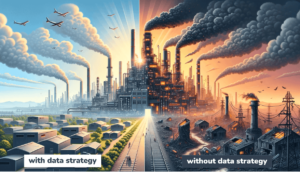Real-time Data Integration
IOblend:
- Supports real-time, production-grade data pipelines using Apache Spark with proprietary tech enhancements.
- Can integrate equally streaming (transactional event) and batch data due to its Kappa architecture.
Talend:
- Offers real-time data integration features but relies on a combination of batch and real-time processing.
Low-code/No-code Development
IOblend:
- Provides low-code/no-code development, accelerating data migration and reducing manual data wrangling.
Talend:
- Features a drag-and-drop designer for designing data integration and ETL processes but might require more configuration and scripting for certain complex tasks.
Data Architecture:
IOblend:
- Enables delivery of both centralized and federated data architectures.
Talend:
- Primarily based on a centralized data architecture, although it can support federated designs with appropriate configurations.
Performance & Scalability:
IOblend:
- Boasts low-latency, massively parallelized data processing with speeds exceeding 10 million transactions per second.
Talend:
- Provides scalable data integration solutions, but performance can vary based on the underlying infrastructure and configuration.
Partnerships & Cloud Integration:
IOblend:
- Has real-time integration capabilities with Snowflake, AWS, Google Cloud and Azure products and is an ISV technology partner with Snowflake and Microsoft.
Talend:
- Offers cloud integration with various platforms including AWS, Google Cloud, Azure, and Snowflake, among others.
User Interface & Design:
IOblend:
- Comprises of two functional parts: IOblend Designer and IOblend Engine.
- IOblend Designer is for designing, building, and testing data pipeline DAGs.
- IOblend Engine performs the calculations and can be flexibly deployed on-prem, cloud or dev machines via containers
Talend:
- Provides a unified studio for designing and executing data integration jobs.
Data Management & Governance:
IOblend:
- Manages data throughout its journey with features like record-level lineage, CDC, metadata, schema, de-duping, cataloguing, etc.
- All as part of each data pipeline automatically (flexible configurations). No need to purchase additional modules.
Talend:
- Also offers robust data governance and data quality tools, but the features may differ in implementation and granularity.
Cost & Licensing:
IOblend:
- The Developer Edition is free, whereas the Enterprise Suite requires a paid annual license.
Talend:
- Provides a free community version (Talend Open Studio) and has premium versions that come at a cost.
Deployment & Flexibility:
IOblend:
- Can operate on any cloud, on-prem, and hybrid environment.
- Comes in two flavours: Developer Edition and Enterprise Edition.
Talend:
- Flexible deployment options across cloud and on-prem environments.
Community & Support:
IOblend:
- As a relatively new solution, the community is still small. Developer Edition support is online. Enterprise Edition receive premium support.
Talend:
- Has a large community (Talend Open Studio) and offers premium support for its enterprise users.
In conclusion, IOblend focuses on real-time data integration with low-code/no-code solutions using Apache Spark and is tailored for more modern data needs, especially in operational analytics.
On the other hand, Talend, being a more established player, offers a wide range of features suitable for various integration scenarios. The choice between the two will depend on the specific needs, infrastructure, and preferences of the enterprise.

Data Strategy: Taking a Business View
Data strategy aligns data-related activities with the strategic goals of an organisation. It’s about turning data into value.

Out with the Old ETL: Navigating the Upgrade Maze
Today, we have tools and experience to make digital transformation easy. Yet, most organisations cling to their antiquated data systems and analytics. Why?

Smart Data Integration: More $ for Your D&A Budget
Data integration is the heart of data engineering. The process is inherently complex and consumes the most of your D&A budget.

Data Pipelines: From Raw Data to Real Results
The primary purpose of data pipelines is to enable a smooth, automated flow of data. Data pipelines are at the core of informed decision-making.

Golden Record: Finding the Single Truth Source
A golden record of data is a consolidated dataset that serves as a single source of truth for all business data about a customer, employee, or product.

Penny-wise: Strategies for surviving budget cuts
Weathering budget cuts, particularly in the realm of data projects, require a combination of resilience, strategic thinking, and a willingness to adapt.
